This Storybook Village in Italy Cooks Fish for Thousands in the World's Largest Frying Pan
Food, fireworks, fairy-tale views, and friendly competition — what more can you ask for in a festival?
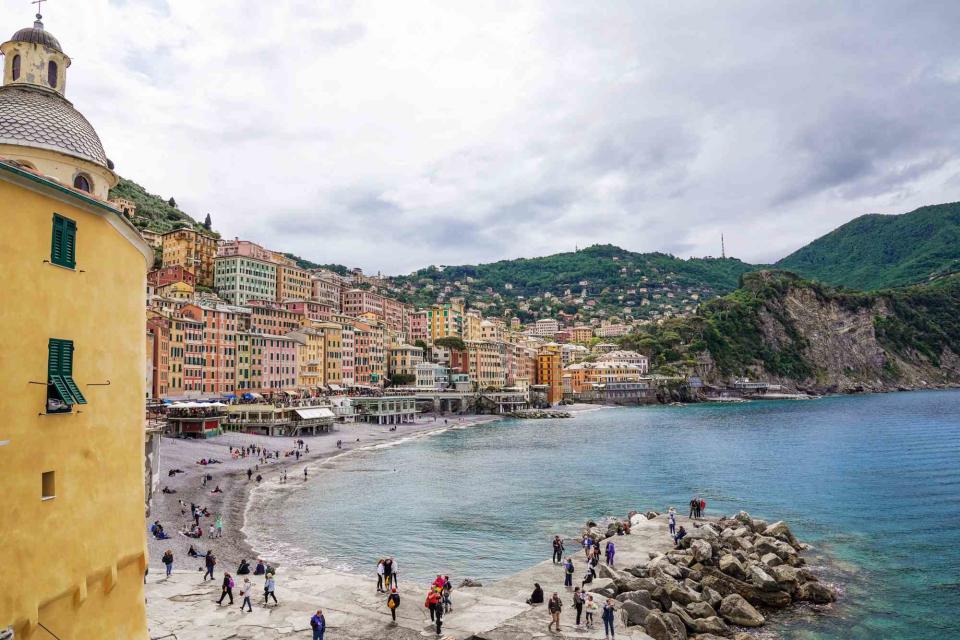
Lauren Breedlove/Travel + Leisure
The flames felt dangerously close as I leaned out of my hotel window. It was the night before the main event, but the largest bonfire I’d ever been privy to made me wonder if the pre-celebratory evening was the actual star attraction. Suspense had been building for two days as I watched the construction of the giant structures on the village’s side-by-side beaches. They were crafted from old furniture, scrap wood, and other used flammable materials that would otherwise be discarded. Ignited by a long firewire from the church steeple, a massive alligator and Titanic replica burned bright, illuminating the large crowd of onlookers crammed onto the promenade.
This kickoff bash was held on the eve of the annual Sagra del Pesce, a fish festival that pays homage to the patron saint of fishermen and the lifeline of the tiny village of Camogli on the Italian Riviera, a stretch of gorgeous coastline along the Ligurian Sea. Since the early 1950s, the second Sunday of every May has been all about fish. Located about 40 minutes south of Genoa by train, Camogli’s quaint harbor, picturesque setting, and pastel-colored buildings could easily grace the pages of a fairy tale. The following day, the world’s largest frying pan — measuring 13 feet in diameter and weighing 28 tons — would be front and center, cooking fried fish for thousands of hungry festival attendees in Piazza Cristoforo Colombo — and I was going to be one of them.
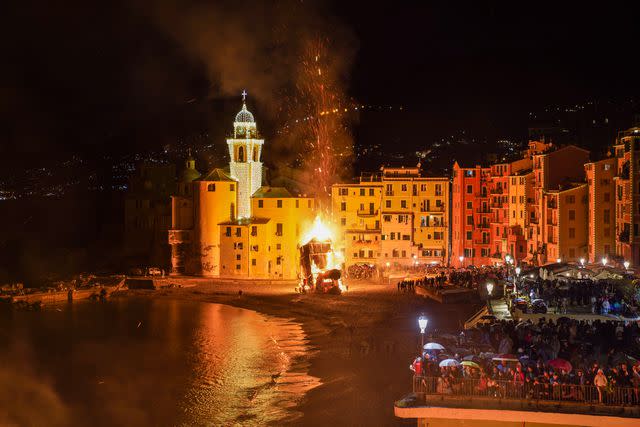
Lauren Breedlove/Travel + Leisure
I had swiftly fallen into a routine in the seaside haven perched in the aptly named Paradise Gulf. My days began with a cappuccino overlooking the iconic skyline from the terrace of Sublimis Boutique Hotel, my home base atop the promenade, a.k.a. Via Giuseppe Garibaldi. After my caffeine fix, I ventured out to explore on foot, and as this was my second time here, I had a solid lay of the narrow network of cobblestone streets. I made a point to visit the original La Padella della Sagra del Pesce (the giant pan) on display at the southern edge of the village.
Walks called for warm slices of focaccia from the famous Revello or gelato from La Cremeria del Paradiso (or both). I enjoyed these treats on the seawall, where I observed the community building their bonfire structures, the themes kept secret until the big reveal that Saturday. Even the kids pitched in with painting and other small jobs involved in the competition between Camogli’s two neighborhoods of Porto and Pinetto.
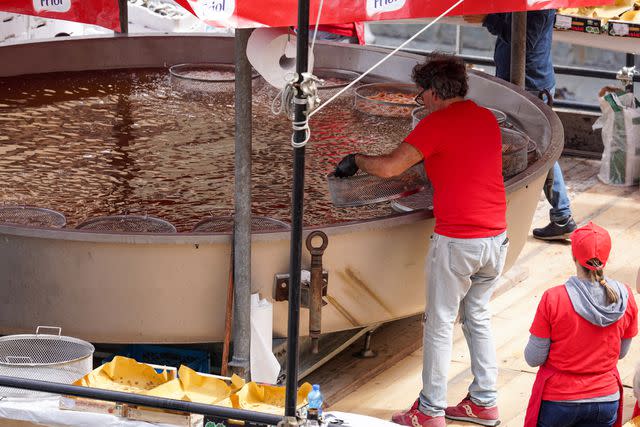
Lauren Breedlove/Travel + Leisure
I alternated afternoons between soaking up the sun, taking a dip in the turquoise sea, and hiking up to the neighboring village of San Rocco, where a sprawling vista of the Ligurian coastline dazzled. Early evenings were for embracing the art of the aperitivo, and I was more than happy to oblige. Chatter wafted from the promenade; tables full of patrons sipping Aperol spritzes and prosecco as the sun dipped closer to the horizon, some holding bar-supplied spray bottles as armor against the cheeky seagulls. I arrived at my chosen haunt from my trip here 10 years prior — The Wine Bar — where I had the perfect view of kids playing their pre-dinner game of soccer on the roof of the Bagni Lido beach bar, becoming dusk-inspired silhouettes as the temperature cooled.
I made my rounds, though, sampling the aperitivo snacks in the name of research at a smattering of watering holes. Barracuda was my new favorite bar and the place I discovered you can, in fact, make an entire dinner out of happy hour snacks — cheeses, squares of focaccia, olives, meats, bruschetta, and more. On one of my last evenings, I ventured away from the promenade, to Via della Repubblica, which runs parallel and is accessed by a dual set of stairs. Here, away from the hustle and bustle, I uncovered the Dragun Pub, which offers the best aperitivo deal in the form of a hefty wine pour for four euros.
Related: 12 Best Small Towns in Italy
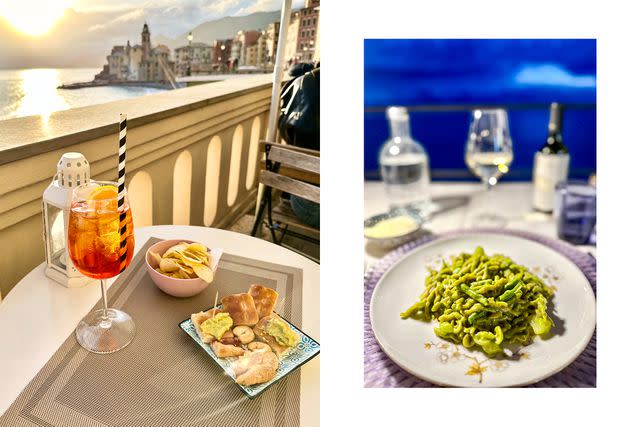
Lauren Breedlove/Travel + Leisure
By the time the festival kicked off, I had already dabbled in the culinary side of Camogli. I found myself at one of Ostaia da ö Sigù's tables strictly based on the aroma of mussels in white wine with garlic. Any establishment that offers a free glass of prosecco while waiting for your seat is top-notch in my book, but the food sealed the deal. I tucked into trofie al pesto, a Ligurian specialty, and had myself a meditative moment. While I had sampled this local dish many times during my stay, this was hands-down the best. The thin, hand-rolled spirals of pasta with potatoes and green beans coated with pesto alla genovese should be paired with vermentino, a Ligurian white wine.
Try the linguine with clams at La Camogliese and pop back up to Via della Repubblica for a meal at La Bossa di Mario - Enoteca con Cucina, situated across from the Dragun Pub. I treated myself to local organic wine, house-made bread, and the special “plin” pasta, a pinched, ravioli-like treasure that melted in my mouth.
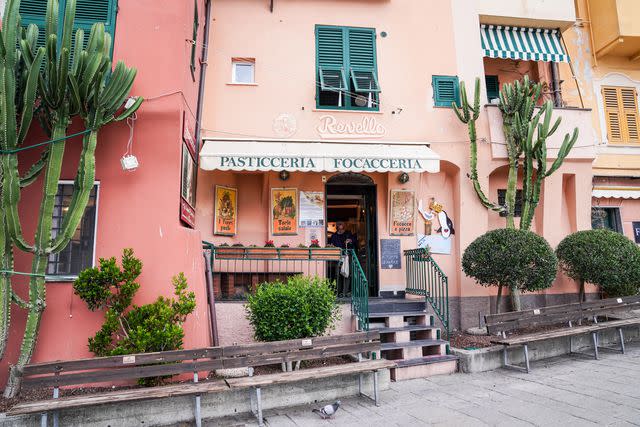
Lauren Breedlove/Travel + Leisure
On Saturday afternoon, I browsed the vendors selling everything from handmade soaps, candy, fruit and flowers to handicrafts inspired by the sea and crafted from wood and ceramics. I was biding my time until the procession, something I’d only seen on television. I made my way up to the church for a front-row seat overlooking the piazza. The San Fortunato (the patron saint of fishing) procession starts there before making a loop around the entire village, ending back at the church for a mass that's held to bring prosperity to the fishermen. My plan was to see the beginning and then run over to the hotel's terrace to view them coming through the promenade. Given that a team of participants was carrying a sizable statue of San Fortunato, tipping the scale at more than 800 pounds, I figured I’d have time to make the five-minute walk.
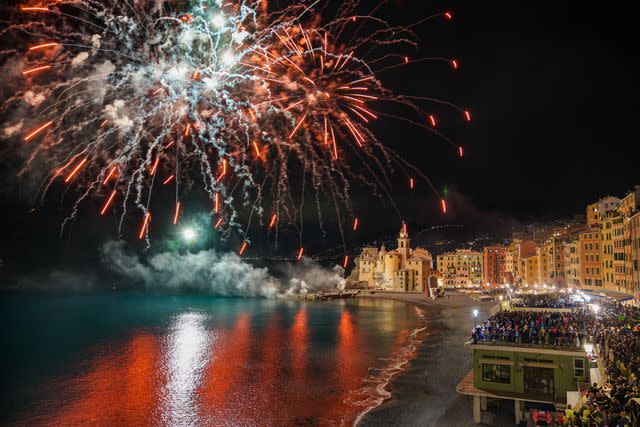
Lauren Breedlove/Travel + Leisure
From the terrace, I watched as they made their way through, signifying the start of the fireworks, which was essentially a 20-minute show at full-on grand finale level. Then, the fire department stood by as the bonfires dramatically set ablaze, the flames shooting into the sky and coming dangerously close to my eyebrows as I peered out of my window. All of this, leading up to Sunday Funday, Italia style. I was like a kid on Christmas morning, barely containing my excitement while seeing pounds upon pounds of fish cooked in an enormous stainless-steel frying pan.
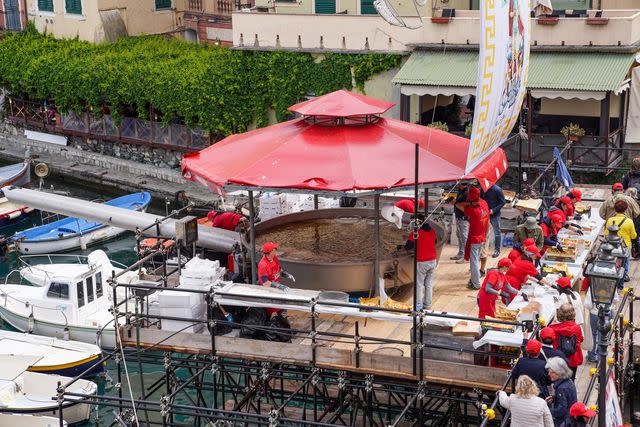
Lauren Breedlove/Travel + Leisure
The line formed long before 10 a.m., when the first fish was set to be served, snaking from the harbor to the promenade through the ancient archway. No tickets were needed, but a six-euro donation was encouraged, with all the proceeds going to charity.
A team of fast-moving volunteers orchestrated this massive cookout under the careful watch of hopeful seagulls that circled maniacally above. I didn’t blame them; it smelled delicious. Crates of fresh fish and calamari were dredged in flour, dumped into the oil-filled pan, and fried to perfection. The line moved quickly and I took my bounty to the beach, along with everyone else. The acciughe (anchovies) were whole, and I’ll admit I wasn’t sure how to eat them. I observed the crowd for a clue and saw locals popping the head off, eating it whole without the tail and bones.
Wine glasses clinked in cafes brimming with festivalgoers as I made my way over to the other culinary highlight: a tent slinging Ligurian specialties like pasta con gamberi e ceci (pasta with chickpeas and shrimp), frittura mista di pesce (mixed fried seafood), and plenty of vino. I was set to leave before dawn the next day and needed one more fix of trofie al pesto, obviously.
For more Travel & Leisure news, make sure to sign up for our newsletter!
Read the original article on Travel & Leisure.

